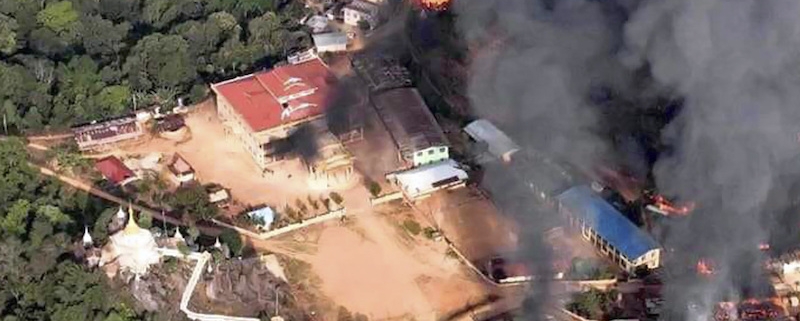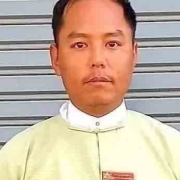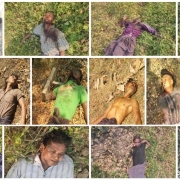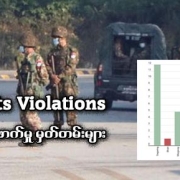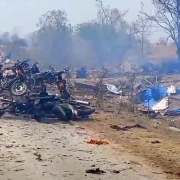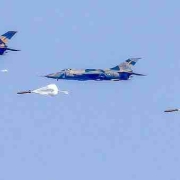Myanmar army kills 21 people sheltering in Shan state monastery, rebels say
3 monks were among those who died in the raid.
UPDATED at 2:39 P.M. EST on 03-13-2023
Junta troops killed 21 locals, including three monks, in a raid on a monastery in Shan state’s Pinlaung township, according to the Karenni and Pa-O National Defense Forces.
In a statement released Sunday, it said the Myanmar army carried out a dawn raid on Nam Neint village — situated about 80 kilometers (50 miles) east of the capital Naypyidaw — on the previous day.
An information officer from the Karenni National Defense Force, which arrived at the scene after the killings, said most of the victims were shot dead.
“We can confirm from our comrades and scouts that the junta troops went into the village,” said the official who declined to be named for security reasons. “We can confirm that … people were killed. Most of them were shot. I think most of the troops were from the army’s 66thDivision.”
He said the bodies were taken away by the Karenni National Defense Force for forensic examination.
Lin Lin, the information officer for the Karenni Revolution Union, told RFA that junta troops stationed at Hpa Yar Taung village entered Nam Neint from the east and began firing at around 5 a.m. on March 11 and the bodies were found at noon the next day.
“We heard the cries of people begging to spare their lives at around 7 p.m. on the 11th. A moment later, we heard the gunfire,” he said.
“We did not expect that they would kill that many people. [When we got to the monastery] we saw dead bodies that the junta troops had dumped the night before. Their blood was still wet. They were shot in the head, point blank. All of their heads were blown apart by gunshots.”
Attempts by RFA to speak with residents who might have a first-hand account of the killings went unanswered on Monday.
Victims included monks, young woman
Around 1,400 residents of Nam Neint and the surrounding area have fled their homes and are sheltering with relatives, at other villages and in monasteries, a refugee aid worker told RFA.
“They were too grief-stricken [and frightened]. Entire villages had to flee to safety,” the aid worker said. “About 200 refugees are sheltering in each place.”
Residents also said the military carried out five airstrikes in the area on March 11 and that junta troops burned down around 60 of Nam Neint’s 200 houses the next morning.
Khun Benjamin, the spokesman for the Pa-O National Defense Force, said that among those killed by the junta troops were three Buddhist monks — including the presiding abbot of the monastery — a woman in her late 20s, and 17 men.
“We found the 5.56mm bullets and casings used in the mass killing that are labeled ‘Ka-Pa-Sa,’ which are the initials for junta weapons factories operating under the ministry of defense,” he said. “Around the monastery, we also found the shells from the artillery attacks that [the military] used to help their ground troops in the raid.”
Khun Benjamin said more bodies had been reported found on the west side of the village.
“We are trying to confirm them, too,” he said.
According to Khun Benjamin, all of the victims had been hiding in the basement of the monastery when they were discovered by the junta troops, who took them to the front of the building and shot them dead.

Junta blames resistance
In a Monday broadcast on regime-controlled Myanmar Radio and Television, junta spokesperson Maj. Gen. Zaw Min Tun accused the Karen National Progressive Party and Karenni National Defense Force of carrying out the killings and putting the blame on junta troops.
“The Pa-O region has always been a peaceful region, but the KNPP and KNDF groups in the south are broadcasting this news to destroy the peace and stability of the Pa-O region, and intend to create illusions between the government and army and Pa-O people,” he said.
His comments followed posts the previous day by pro-military accounts on the social media platform Telegram that included photos of the victims together with handmade guns and hunting rifles and which accused the People’s Defense Forces of the mass killing.
Notably, the weapons were not in the hands of the dead in the photos, which metadata shows were taken at 8:55 a.m. on March 12. None of the people in the photos appear to have been carrying ammunition bags, which is typical of members of the armed resistance.
Members of the Karenni coalition forces also told RFA that their fighters do not carry the types of guns seen in the photos, only automatic rifles, and said no weapons were found on the dead when they were able to enter the monastery.
Fighting between the army, ethnic Karenni fighters and local People’s Defense Forces has intensified in Shan state in recent weeks, according to members of the anti-junta forces.
There are currently around 200,000 refugees of conflict in Pinlaung township and nearby Mobye region in southern Shan state who are in desperate need of food and water, aid workers told RFA.
Call to UN Security Council
News of Saturday’s killings came ahead of a session of the United Nations Security Council on Myanmar on Monday that included reports from Noeleen Heyzer, the U.N. secretary-general’s special envoy on Myanmar, and Retno Marsudi, Indonesia’s foreign minister and head of the Association of Southeast Asian Nations office of the special envoy on Myanmar.
Ahead of the session, New York-based Human Rights Watch urged Security Council members to take action beyond the body’s December resolution on Myanmar, which denounced the military’s rights violations since the February 1, 2021 coup.
“The council should take meaningful actions under Chapter VII of the U.N. Charter, including instituting a global arms embargo, referring the country situation to the International Criminal Court, and imposing targeted sanctions on junta leadership and military-owned companies,” Human Rights Watch said in a statement.
Louis Charbonneau, U.N. director at Human Rights Watch, said that the junta had “demonstrated it’s impervious to statements of condemnation or concern.”
“Its disregard of the Security Council’s December resolution shows the need for a new resolution imposing strong measures like an arms embargo and targeted sanctions for senior military officials and companies linked to the military,” he said.
Human Rights Watch noted that while the December council resolution called for “full, safe and unhindered humanitarian access … [to] increasingly large numbers of internally displaced persons and dramatic increase in humanitarian need,” the junta has blocked aid from reaching them as a form of collective punishment.
It also noted that junta chief Senior Gen. Min Aung Hlaing has rejected each point of ASEAN’s “five-point consensus” of April 2021 to end violence in Myanmar, “exploiting the international community’s deference to the regional bloc.”
“As this year’s ASEAN chair, Indonesia should reroute the bloc’s approach to more effectively isolate the Myanmar junta while soliciting ASEAN support for additional Security Council measures and cooperation with other countries’ efforts to block the flow of revenue and arms to the junta,” the statement said.
Translated by RFA Burmese. Edited by Mike Firn and Joshua Lipes.
This story has been updated to include comments by aid workers and members of the armed resistance, as well as a statement by Human Rights Watch calling for additional pressure from the U.N. Security Council.

